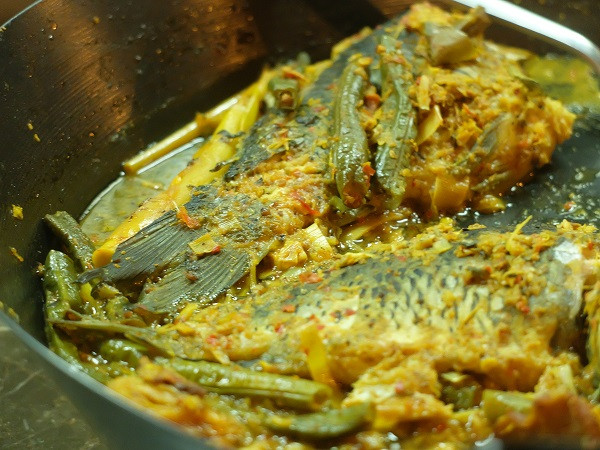Popular Reads
Top Results
Can't find what you're looking for?
View all search resultsPopular Reads
Top Results
Can't find what you're looking for?
View all search resultsFood storytelling: A contemporary record of Indonesian cuisines
Food storytelling is not just a hobby. Along with the rise of culinary tourism, it has become key to keeping Indonesia's culinary traditions alive for generations to come.
Change text size
Gift Premium Articles
to Anyone
C
ulinary tourism has been rising in popularity and has become a lucrative niche in recent years, making it one of the hottest topics among bloggers and conventional media.
While traditional tourism coverage only highlighted tourist destinations, culinary centers are no longer overlooked and are even in the media spotlight today.
In Indonesia, the pioneer of culinary tourism in mainstream media is the late Bondan Winarno, a former investigative journalist who travelled across the archipelago's many regions and even abroad.
Bondan savored a variety of Indonesian cuisines as well as foreign cuisines. He published the stories of his culinary adventures and hosted several TV programs on the topic.
Inspired by Bondan, Indonesian bloggers then began developing their own blogs to focus primarily on culinary tourism.
At a recent Jakarta discussion on culinary developments, celebrity chef and culinary entrepreneur William Wongso described the close connection food has with local culture and history.
For example, William pointed out that the dishes for the Balinese ngaben (cremation ceremony) required distinctive decorations and the best ingredients, as they were offerings to the deities of Balinese Hinduism.
Reno Andam Suri, who specializes in food storytelling and promoting Sumatran cuisines, mentioned how western Sumatra’s famous rendang – a traditional beef dish stewed in coconut milk and spices – used different ingredients in the montane culture of Bukittinggi and in the coastal culture of Padang.
“The difference is in the kinds of coconut and some of the spices, so that the texture of the resulting rendang are not the same,” she said.
Food also has connections with the cook-owner of a particular eatery, who is usually referred to as a "food persona".
Willliam mentioned Mbah Lindu, who sells gudeg (young jackfruit stewed in spiced coconut sauce) at a roadside stall on Jl. Sosrowijayan in Yogyakarta.
The Yogyakarta dish can be found all over the city, but Mbah Lindu – reportedly a nonagenarian – continues to cook and serve her famed version to customers.
“Anything could be the reason for her continuing customer service, even though she could simply leave the job to her children or grandchildren,” said William.
In the same vein, Reno spoke of Gustiati who makes bika lintau, a small round cake made from rice flour and coconut comparable to Java’s apam that the third-generation traditional baker sells at Payakumbuh Market in Payakumbuh, West Sumatra.
“Ibu Gustiati feels that making bika lintau is not only a means of livelihood, but also a mission to preserve the [traditional] cake amid the prevalence of modern cakes and cookies,” said Reno.
Alongside William and Reno, the discussion also featured Ade Putri Paramadita, whose enthusiasm in sharing her thoughts on the foods she eats on her social media channels has made her one of the most influential culinary storytellers in the country.
Ade believes food should not be described simply as “tasty” or “not tasty”.
“We should be able to describe the flavors, ingredients, spices and even the complexity or blandness of the flavors,” she said, and that a food storyteller should utilize all five senses to perceive food through its form, textures, aromas and flavors.
Ade recounted when she ate kidu (palm weevil larvae) both raw and cooked at a food stall in North Sumatra.
The larvae, pupae and adult form of the beetle species lives on sugar palms in Kabanjahe, North Sumatra, or on sago palms in West Papua and North Sulawesi.
“At first I felt creeped out, but when I put it into my mouth and bit into it, the worm turned out to have a piquant taste like raw coconut milk,” said Ade.
She then tried larvae cooked with crushed sweet potato leaves, and they tasted similarly piquant, but with a firmer texture.
Food storytelling of Ade's kind was important, said William, especially with regard to Indonesia’s culinary treasures, as it helped persuade people to try the specialties of the country's diverse culinary traditions and document the dishes, their history and creators or provenance.
Sadly, limited manuscripts are available that document the foods and dishes of the country's historical era of kingdoms and sultanates.
“Recipes and food stories were mostly handed down orally, so they are hard to trace when the persons who were knowledgeable about these things have died,” said William.
Sari Novita, a blogger and author currently writing a novel on the cuisine of medieval Indonesia, is facing just this difficulty.
She has consulted translations of old texts and interviewed several researchers of medieval manuscripts, but has found even the experts’ explanations insufficient to complete her book.
The cooks and storytellers of the past handed down their recipes orally using regional languages and old dialects, many of which are not spoken or understood today. The accounts of the foods and dishes of bygone eras had therefore disappeared before they had ever been recorded.
Finally, food storytellers were expected to recount more than the flavor of the food they taste, but the stories behind it and its connection to the culture and history of its area of origin. The food storytellers' writings thus constituted a vital step in documenting Indonesian cuisines in today's digital and print formats, so they were not be lost to time.











